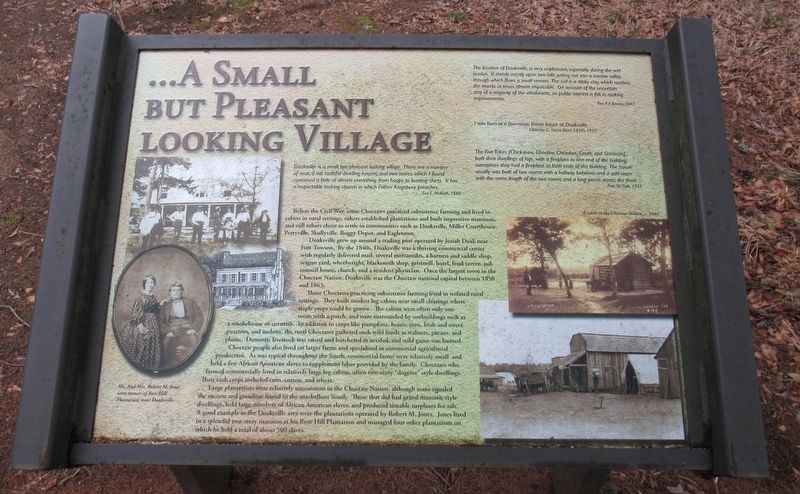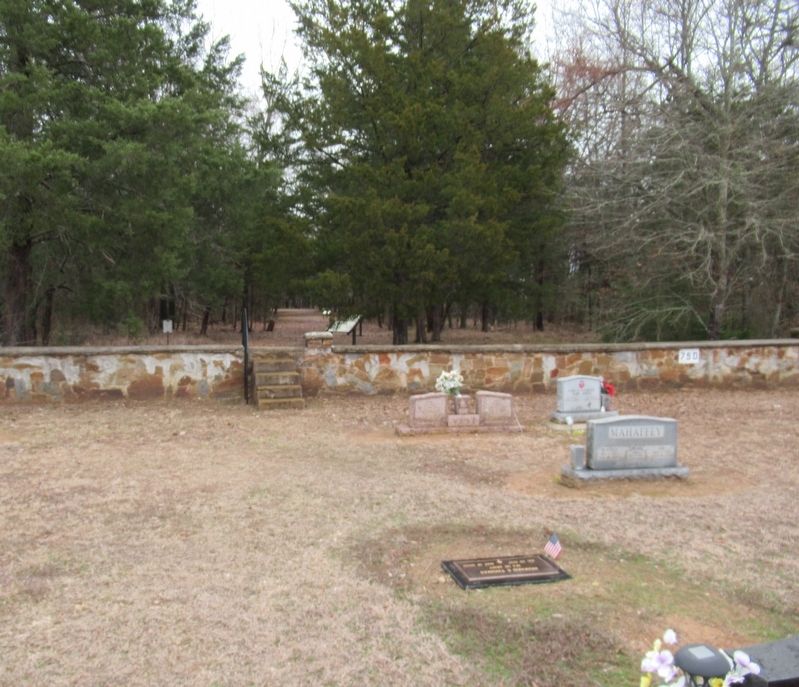Near Fort Towson in Choctaw County, Oklahoma — The American South (West South Central)
...A Small But Pleasant Looking Village
"Doaksville is a small but pleasant looking village. There are a number of neat, if not tasteful dwelling houses, and two stores, which I found contained a little of almost everything from hoops to hunting shirts. It has a respectable looking church in which Father Kingsbury preaches."
Sue L McBeth, 1860
Before the Civil War, some Choctaws practiced subsistence farming and lived in cabins in rural settings, others established plantations and built impressive mansions, and still others chose to settle in communities such as Doaksville, Miller Courthouse, Perryville, Skullyville, Boggy Depot, and Eagletown.
Doaksville grew up around a trading post operated by Josiah Doak near Fort Towson. By the 1840s, Doaksville was a thriving commercial center with regularly delivered mail, several mercantiles, a harness and saddle shop, wagon yard, wheelwright, blacksmith shop, gristmill, hotel, food tavern, jail, council house, church, and a resident physician. Once the largest town in the Choctaw Nation, Doaksville was the Choctaw national capital between 1850 and 1863.
Those Choctaws practicing subsistence farming lived in isolated rural settings. They built modest log cabins near small clearings where staple crops could be grown. The cabins were often only one room with a porch, and were surrounded by out buildings such as a smokehouse or corncribs. In addition to crops like pumpkins, beans, corn, Irish and sweet potatoes, and melons, the rural Choctaws gathered such wild foods as walnuts, pecans, and plums. Domestic livestock was raised and butchered as needed, and wild game was hunted. Choctaw people also lived on larger farms and specialized in commercial agricultural production. As was typical throughout the South, commercial farms were relatively small and held a few African Americans slaves to supplement labor provided by the family. Choctaws who farmed commercially lived in relatively large log cabins, often two-story "dogtrot" style dwellings. Their cash crops included corn, cotton, and wheat.
Large plantations were relatively uncommon in the Choctaw Nation, although some equaled the success and grandeur found in the antebellum South. Those that did had grand mansion-style dwellings, held large numbers of African American slaves, and produced sizeable surpluses for sale. A good example in the Doaksville area were the plantations operated by Robert M. Jones. Jones lived in a splendid two-story mansion at his Rose Hill Plantation and managed four other plantations on which he held a total of about 500 slaves.
"The location of Doaksville, is very unpleasant, especially during the wet season. It stands mostly upon two hills, jutting
out into a narrow valley, through which flows a small stream. The soil is a sticky clay, which renders the streets at times almost impassible. On account of the uncertain stay of a majority of the inhabitants, no public interest is felt in making improvements." Rev. P.P. Brown, 1847
"I was born in a four-room frame house at Doaksville."
Clemme G. Socra (born 1859), 1937
"The Five Tribes [Chickasaw, Choctaw, Cherokee, Creek, and Seminole] built their dwellings of logs, with a fireplace in one end of the building, sometimes they had a fireplace at both ends of the building. The house usually was built of two rooms with a hallway between and a side room with the same length of the two rooms and a long porch across the front." Pete W. Cole, 1937
Captions: Left: Mr. and Mrs. Robert M. Jones were owners of Rose Hill Plantation, near Doaksville.
Right: A cabin in the Choctaw Nation, c. 1889
Erected by Oklahoma Historical Society.
Topics. This historical marker is listed in these topic lists: Agriculture • Native Americans • Settlements & Settlers. A significant historical year for this entry is 1840.
Location. 34° 2.05′ N, 95° 16.347′ W. Marker is near Fort Towson, Oklahoma, in Choctaw County. Marker can be reached from Red Road, one mile north of U.S. 70, on the right when traveling north. Inside of the Fort Towson Cemetery on the back wall is a set of stairs that leads into the Old Doaksville Townsite History Trail. The marker is located along the trail. Touch for map. Marker is in this post office area: Fort Towson OK 74735, United States of America. Touch for directions.
Other nearby markers. At least 8 other markers are within walking distance of this marker. Roads and Rivers (here, next to this marker); The End of Doaksville (within shouting distance of this marker); The Treaty of Doaksville, 1837 (about 300 feet away, measured in a direct line); Archaeology at Doaksville (about 400 feet away); Old Doaksville Cemetery (about 500 feet away); Doaksville Cemetery (about 600 feet away); The Old Stone Jail (about 600 feet away); Dedicated To Veterans Who Served (about 600 feet away). Touch for a list and map of all markers in Fort Towson.
Credits. This page was last revised on December 8, 2023. It was originally submitted on December 5, 2023, by Jason Armstrong of Talihina, Oklahoma. This page has been viewed 79 times since then and 35 times this year. Photos: 1. submitted on December 5, 2023, by Jason Armstrong of Talihina, Oklahoma. 2. submitted on December 6, 2023, by Jason Armstrong of Talihina, Oklahoma. • J. Makali Bruton was the editor who published this page.

